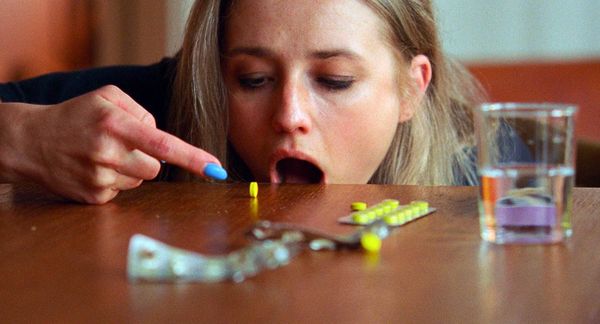Eye For Film >> Movies >> Sick Of Myself (2022) Film Review
Sick Of Myself
Reviewed by: Nikola Jovic

In today's world, hell most certainly is other people, not for the reason of alienation, but for daring to be out of signal while everyone else is virtue signaling. Kristoffer Borgli has got his fingers on the beating pulse of the media culture of today. After pulling out his directorial scalpel for a mockumentary vivisection with his first feature Drib (2017), this time around he’s picking up the remains and showing them in full display in his first proper fictional feature. Sick Of Myself premiered earlier this year at Cannes Film Festival, grabbing a nomination in the Un Certain Regard Award section, and has, just recently, been shown at Palić Film Festival as a part of its Official Selection.
The story follows Signe (Kristine Kujath Thorp) and Thomas (Eirik Sæther), a dysfunctional couple of delusional narcissists. He is a brazen kleptomaniac, hustling his way into the art world by making installations out of stolen furniture. At the opposite end of the spectrum, she is a self-congratulatory manager at the bakery, jealously trying to keep up with her boyfriend but always remaining on the edge of any meaningful recognition of her (pre)supposed worth. That is, until one day, when she instinctively jumps to help out a woman bleeding to death due to an angry dog’s bite. Walking home from work, dripping in someone else's blood, although proud of herself, she feels that people treat her differently when they assume that she’s the victim. Suddenly, for the first time, Signe is being showered with much-deserved attention. Like most things in life, this too passes, but her need to be the centre of attention remains. If only there was a way to obtain it. And obtain it she will, by a way of overmedication on a fictitious illegal drug called Lidexol — that, as its side effect, turns your skin into a worst crack addiction Cronenbergesque nightmare.

Over the years Borgli has developed a style out of combining elements of body horror with his cynical and ironic sense of humour. It's an approach that results in a sort of bizarre pleasure in pain (jouissance), and with characters making such decisions that elicit out of you an inward: “don’t do it” screaming, all the while knowing that their fate has already been decided. Signe, played adroitly by Thorp, represents this sentiment of pleasure in pain most succinctly. For a moment there, it appears as if her ploy to get everyone’s attention could actually work, but as her skin condition starts to deteriorate it becomes obvious that she’s crushing under the weight of her own hubris and misplaced ambition.
This type of: “don’t do it” film, like Repulsion (1965), or more recently, Ingrid Goes West (2017), get their strength not from the characters' forward-momentum movement of their wants and needs, but in their attempt to keep on doing exactly the same thing while their lives are crumbling under that weight. That’s perhaps best exemplified in one of the scenes where Signe is posing in a museum as a photo model for a gender-neutral inclusive brand named Regardless. While changing positions, Signe is glancing at the statues made of marble — faces smiling, all pristine, forever in a perfect shape and pose — and as she’s posing in a similar manner like a statue herself, you can see that she feels as if she belongs among them. But we also see that by doing so she’s literally destroying herself.
The film is less about ambition or striving for success, as it’s about the fetishisation of that image of success, and how striving for the perfect image can destroy you. Furthermore, it deals with the opportunistic way the media latches onto that image of victimhood Like the tagline of the brand Signe is posing for says: “It’s Regardless when it fits” but in order to fit, one has to change, shift and contour his or her real self to such an extent to fit the imaginary. Like Thetis in ancient Greek mythology, its identity is forged by destructive plasticity.
On the technical side, the whole make-up and lighting department make sure that the look of body deformity appears convincing enough while still pushing it for dramatic effect, sometimes even carrying the film. These elements need a great story to support this foundation, and although the narrative starts running low on gas in the second half, repeating similar beats, it varies and escalates them enough that it manages to carry the load. To its detriment, even if it is unquestionably funny, the cynicism of its humour walks on the very edges of appropriate and politically correct. In some instances serving as a poignant social commentary, while in others merely as a crude joke at the expense of the characters on screen. Aside from that, the rest of the film works as a sometimes upsetting, at other times uncomfortably hilarious piece of filmmaking. Coupled with some snappy editing, done by the director himself, this film adds up to one hell of a gut punch.
Reviewed on: 27 Jul 2022
















